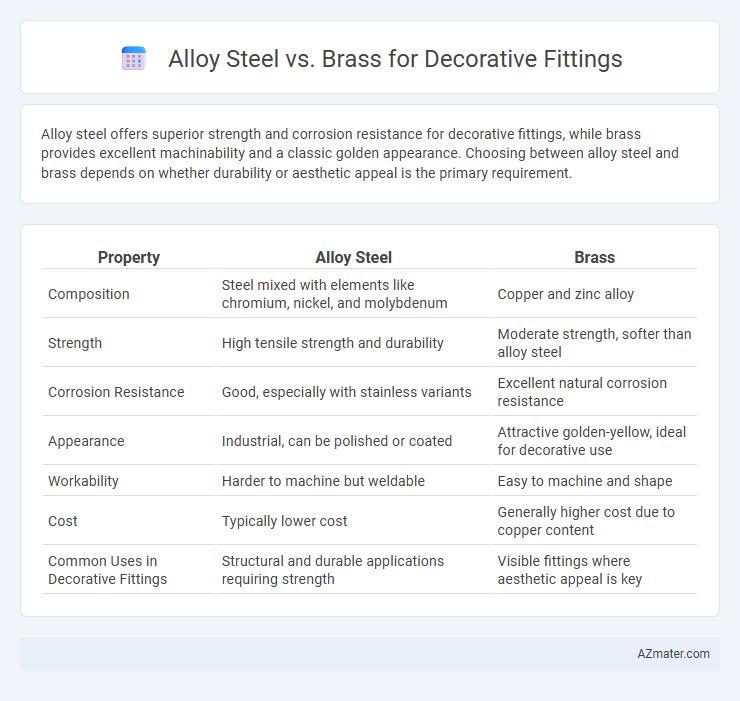Alloy steel offers superior strength and corrosion resistance for decorative fittings, while brass provides excellent machinability and a classic golden appearance. Choosing between alloy steel and brass depends on whether durability or aesthetic appeal is the primary requirement.
Table of Comparison
| Property | Alloy Steel | Brass |
|---|---|---|
| Composition | Steel mixed with elements like chromium, nickel, and molybdenum | Copper and zinc alloy |
| Strength | High tensile strength and durability | Moderate strength, softer than alloy steel |
| Corrosion Resistance | Good, especially with stainless variants | Excellent natural corrosion resistance |
| Appearance | Industrial, can be polished or coated | Attractive golden-yellow, ideal for decorative use |
| Workability | Harder to machine but weldable | Easy to machine and shape |
| Cost | Typically lower cost | Generally higher cost due to copper content |
| Common Uses in Decorative Fittings | Structural and durable applications requiring strength | Visible fittings where aesthetic appeal is key |
Introduction to Alloy Steel and Brass
Alloy steel, composed primarily of iron with added elements like chromium, nickel, and molybdenum, offers superior strength and corrosion resistance compared to traditional carbon steel. Brass, an alloy of copper and zinc, is prized for its aesthetic appeal, excellent machinability, and natural resistance to tarnish, making it a popular choice for decorative fittings. The distinct metal properties of alloy steel provide durability and modern appearance, while brass delivers classic elegance and versatility in decorative applications.
Composition and Material Properties
Alloy steel, primarily composed of iron mixed with elements like chromium, nickel, and molybdenum, offers high tensile strength, corrosion resistance, and excellent durability, making it suitable for decorative fittings requiring robustness. Brass, an alloy of copper and zinc, provides superior malleability, aesthetic appeal with its golden hue, and good corrosion resistance in non-extreme environments, ideal for ornamental applications. The choice depends on the specific need for mechanical strength or decorative finish, where alloy steel emphasizes structural integrity while brass focuses on visual elegance.
Aesthetic Appeal and Finishes
Alloy steel offers a sleek, modern look with a smooth finish that resists tarnishing and corrosion, making it ideal for contemporary decorative fittings. Brass provides a warm, classic appearance with a natural golden hue and ages gracefully with a patina, enhancing vintage or traditional designs. Both materials support diverse finishing techniques such as polishing, plating, or brushing, allowing customization to match varied aesthetic preferences.
Durability and Corrosion Resistance
Alloy steel offers superior durability compared to brass, making it ideal for decorative fittings requiring strength and long-lasting performance. Brass provides excellent corrosion resistance, especially in moist environments, preventing tarnish and maintaining aesthetic appeal over time. Selecting alloy steel ensures robustness against wear and mechanical stress, while brass guarantees enduring resistance to oxidation and rust in decorative applications.
Cost Comparison
Alloy steel fittings generally have a higher initial cost compared to brass due to their enhanced strength and durability properties, making them suitable for long-term, heavy-duty applications. Brass fittings, while typically less expensive upfront, offer excellent corrosion resistance and aesthetic appeal, often preferred for decorative purposes where cost-efficiency is important. When comparing cost-effectiveness, alloy steel may result in lower replacement and maintenance expenses over time despite the higher purchase price.
Machinability and Workability
Alloy steel offers superior strength and durability for decorative fittings but typically requires more specialized machining tools due to its hardness, affecting machinability. Brass, known for its excellent machinability and inherent corrosion resistance, allows easier cutting, shaping, and polishing, making it a preferred choice for intricate and detailed decorative work. Workability of brass also surpasses alloy steel since it can be easily formed and soldered without compromising its surface aesthetics.
Maintenance Requirements
Alloy steel decorative fittings require minimal maintenance due to their corrosion resistance and durability, reducing the need for frequent cleaning or protective coatings. Brass fittings, while aesthetically appealing and resistant to tarnishing, demand regular polishing to maintain their luster and prevent oxidation over time. Choosing alloy steel for decorative fittings enhances longevity and lowers upkeep costs compared to the higher maintenance involved with brass.
Environmental Impact
Alloy steel, composed primarily of iron mixed with elements like chromium and nickel, offers superior durability and recyclability compared to brass, which consists mainly of copper and zinc. The extraction and processing of brass often result in higher energy consumption and greater emissions due to copper mining's environmental impact. Choosing alloy steel for decorative fittings reduces ecological footprint by promoting material reuse and minimizing heavy metal contamination associated with brass production.
Common Applications in Decorative Fittings
Alloy steel is commonly used in decorative fittings where high strength, durability, and corrosion resistance are essential, such as in structural hardware, door handles, and ornamental railings. Brass, valued for its aesthetic appeal and excellent machinability, is often chosen for decorative fittings like drawer pulls, light fixtures, and intricate trim details due to its natural golden color and resistance to tarnish. Both materials serve distinct functional and decorative purposes, with alloy steel prioritizing performance and brass emphasizing visual elegance in various architectural and interior design applications.
Choosing the Right Material for Your Project
Alloy steel offers superior strength, corrosion resistance, and durability, making it ideal for decorative fittings in high-stress or outdoor environments. Brass provides excellent malleability, natural antimicrobial properties, and a warm golden appearance, perfect for intricate designs and indoor applications where aesthetics are prioritized. Selecting between alloy steel and brass depends on the balance between mechanical requirements and desired visual appeal in your decorative project.

Infographic: Alloy steel vs Brass for Decorative fitting
 azmater.com
azmater.com